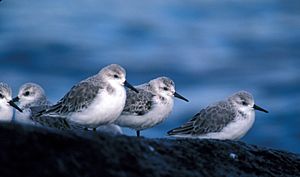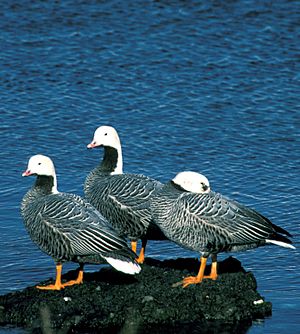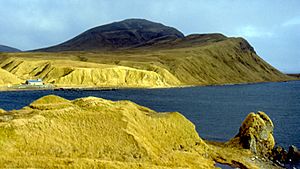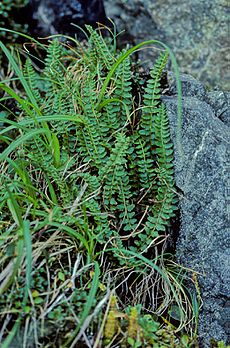Adak Island facts for kids
|
Native name:
Adaax
|
|
|---|---|
|
Location in Alaska
|
|
| Geography | |
| Location | Bering Sea |
| Coordinates | 51°47′N 176°38′W / 51.78°N 176.64°W |
| Area | 274.6 sq mi (711 km2) |
| Area rank | 25th largest island in the United States |
| Length | 32.67 mi (52.58 km) |
| Width | 21.7 mi (34.9 km) |
| Highest elevation | 3,924 ft (1,196 m) |
| Administration | |
| Largest settlement | Adak (pop. 326) |
| Demographics | |
| Population | 45 (2022) |
| Pop. density | 0.84 /km2 (2.18 /sq mi) |
Adak Island (Aleut: Adaax, Russian: Адак), also known as Father Island, is a small piece of land in Alaska. It is part of the Aleutian Islands chain, located in the Bering Sea. The city of Adak, the southernmost city in Alaska, is found on this island.
Adak Island is about 711 square kilometers (275 square miles) big. It is one of the largest islands in the United States. Because of strong winds, cloudy skies, and cold weather, most plants are tundra. This means you'll see grasses, mosses, and small flowering plants. The highest spot is Mount Moffett, which is 1,196 meters (3,924 feet) tall. It is covered in snow for most of the year.
The name Adak comes from the Aleut language. It means "father."
Contents
Island History: What Happened on Adak?
Adak Island has been home to the Aleut people for a very long time. Russian explorers visited the island in the 1700s but did not build any lasting settlements.
Adak Island During World War II
During World War II, the Japanese army took over two islands near Adak: Attu and Kiska. These were the first times an enemy had occupied American soil since the War of 1812. The Japanese also attacked an American base at Dutch Harbor from the air.
In response, the U.S. military decided to push the Japanese out. They built airfields and bases on the western Aleutian Islands. Adak Island was chosen for an airfield, and planes started flying from there in September 1942.
- On May 11, 1943, American soldiers landed on Attu Island. They fought the Japanese there. This battle was very costly, with many lives lost on both sides.
- Later, on August 15, 1943, U.S. and Allied soldiers landed on Kiska Island. They expected another big fight. However, the Japanese had secretly left the island. Even so, over 300 Allied soldiers died from accidents like friendly fire or hidden mines.
After the war, many American soldiers remembered Adak for its cold, foggy, and windy weather. They lived in simple huts and rarely had fresh food.
Adak After the War
Adak Naval Air Station stayed a military base during the Cold War. But it closed in March 1997. Soon after, the town of Adak was officially formed where the base used to be. The island's population dropped from 6,000 to 326 residents by 2010.
In 1980, the Aleutian Islands National Wildlife Refuge was created. Much of Adak Island is now part of this wildlife area.
Caribou on Adak Island
In the late 1950s, the Alaska Department of Fish and Game brought about 23 caribou calves to the island. This was done to help prevent food shortages. Today, Adak Island has a large caribou herd of about 1,000 animals. This makes it a popular place for hunting.
Adak Island's Climate
Adak has a cool, wet climate. It often has cloudy skies, strong winds, and a lot of rain.
- Clouds and Fog: Adak is cloudy nearly 75 percent of the time in June and July. It averages 173 days of fog each year. July and August are the foggiest months.
- Winds: Strong winds, called gales, can happen any month of the year. They are most common from December to March.
- Temperatures: Average temperatures range from -6 to 16 degrees Celsius (20 to 60 degrees Fahrenheit). The highest temperature recorded was 24 degrees Celsius (75 degrees Fahrenheit) in August 1956. The lowest was -16 degrees Celsius (3 degrees Fahrenheit) in January 1963 and February 1964.
- Rain and Snow: Adak gets about 139 centimeters (54.8 inches) of rain each year. The wettest months are from October to January. Snowfall averages about 254 centimeters (100 inches), mostly on the volcanoes. Adak has measurable rain or snow on about 341 days each year.
| Climate data for Adak, Alaska (1981–2010 normals, extremes 1942–present) | |||||||||||||
|---|---|---|---|---|---|---|---|---|---|---|---|---|---|
| Month | Jan | Feb | Mar | Apr | May | Jun | Jul | Aug | Sep | Oct | Nov | Dec | Year |
| Record high °F (°C) | 52 (11) |
54 (12) |
57 (14) |
56 (13) |
65 (18) |
67 (19) |
73 (23) |
75 (24) |
71 (22) |
62 (17) |
63 (17) |
55 (13) |
75 (24) |
| Mean maximum °F (°C) | 44.4 (6.9) |
45.2 (7.3) |
45.8 (7.7) |
48.9 (9.4) |
52.1 (11.2) |
56.8 (13.8) |
64.8 (18.2) |
67.6 (19.8) |
60.6 (15.9) |
55.0 (12.8) |
49.5 (9.7) |
46.5 (8.1) |
69.1 (20.6) |
| Mean daily maximum °F (°C) | 37.3 (2.9) |
38.0 (3.3) |
39.4 (4.1) |
42.0 (5.6) |
45.8 (7.7) |
49.8 (9.9) |
54.6 (12.6) |
57.2 (14.0) |
53.1 (11.7) |
48.5 (9.2) |
42.8 (6.0) |
38.9 (3.8) |
45.6 (7.6) |
| Daily mean °F (°C) | 32.7 (0.4) |
33.5 (0.8) |
35.0 (1.7) |
37.6 (3.1) |
41.4 (5.2) |
45.5 (7.5) |
50.0 (10.0) |
52.0 (11.1) |
48.5 (9.2) |
43.7 (6.5) |
38.1 (3.4) |
34.3 (1.3) |
41.0 (5.0) |
| Mean daily minimum °F (°C) | 28.0 (−2.2) |
29.0 (−1.7) |
30.6 (−0.8) |
33.1 (0.6) |
37.0 (2.8) |
41.2 (5.1) |
45.3 (7.4) |
46.9 (8.3) |
43.9 (6.6) |
39.0 (3.9) |
33.4 (0.8) |
29.6 (−1.3) |
36.4 (2.4) |
| Mean minimum °F (°C) | 12.9 (−10.6) |
17.4 (−8.1) |
19.9 (−6.7) |
25.8 (−3.4) |
30.8 (−0.7) |
35.8 (2.1) |
40.2 (4.6) |
40.0 (4.4) |
34.2 (1.2) |
29.8 (−1.2) |
24.9 (−3.9) |
18.1 (−7.7) |
10.6 (−11.9) |
| Record low °F (°C) | 3 (−16) |
3 (−16) |
11 (−12) |
20 (−7) |
20 (−7) |
29 (−2) |
33 (1) |
33 (1) |
28 (−2) |
22 (−6) |
12 (−11) |
8 (−13) |
3 (−16) |
| Average precipitation inches (mm) | 6.09 (155) |
4.05 (103) |
4.98 (126) |
3.14 (80) |
2.87 (73) |
2.79 (71) |
2.63 (67) |
4.22 (107) |
5.48 (139) |
6.19 (157) |
6.30 (160) |
5.96 (151) |
54.70 (1,389) |
| Average snowfall inches (cm) | 24.8 (63) |
17.3 (44) |
19.3 (49) |
7.7 (20) |
1.3 (3.3) |
0.0 (0.0) |
0.0 (0.0) |
0.0 (0.0) |
trace | 0.6 (1.5) |
10.8 (27) |
20.6 (52) |
102.4 (260) |
| Average precipitation days (≥ 0.01 inch) | 25.7 | 22.3 | 25.4 | 21.6 | 22.3 | 16.4 | 15.5 | 19.4 | 21.6 | 24.9 | 24.4 | 26.8 | 266.3 |
| Average snowy days (≥ 0.1 in) | 18.2 | 15.4 | 16.4 | 11.6 | 2.6 | 0.0 | 0.0 | 0.0 | 0.1 | 1.0 | 10.0 | 15.9 | 91.2 |
| Source 1: NOAA | |||||||||||||
| Source 2: XMACIS2 (mean maxima/minima 1981–2010) , WRCC (extremes) | |||||||||||||
Education on Adak Island

Adak used to have the Adak School, which taught students from kindergarten to 12th grade. It had about 20 students. However, the school closed on June 23, 2023, because there were not enough students.
Adak Island's Economy

Most of the old naval facilities on Adak Island have been given to the Aleut Corporation. Part of the island is still a wildlife refuge.
- Fishing: Adak is now a place where foreign fishing fleets can refuel and transfer their crews. It has an airport, docks, housing, and food services. A grocery store, ship supply store, and restaurant opened in 1999.
- Seafood Processing: Norquest-Adak Seafood Co., an Alaskan company, processes fish like Pacific cod, pollock, and halibut.
- Local Fishing: A few residents have permits for commercial fishing, mainly for groundfish.
- Netflix Series: In 2022, Netflix released a show about explorers looking for pirate gold on the island.
Getting Around Adak Island
Because it used to be a naval air station, Adak has a large and modern airport.
- Adak Airport: The Adak Airport is run by the State of Alaska. It has a control tower and two long runways.
- Flights: Alaska Airlines flies passenger and cargo jets from Anchorage twice a week. These flights usually happen on Wednesdays and Saturdays, if the weather allows.
- Docks: Adak also has three deep-water docks and places to refuel ships. The city wants to make the Sweeper Cove small boat harbor much bigger.
- Roads: There are about 16 miles (26 km) of paved and dirt roads on Adak. These roads are owned by the Aleut Corporation.
Adak Island's Plants
The Aleutian shield fern is a special plant found only on Adak Island. It is an endangered species.
There's also a small group of trees on the island jokingly called Adak National Forest.
Adak Island's Geology
The Adagdak and Mount Moffett volcanoes are located on Adak. A type of igneous rock called adakite is named after Adak Island.
See also
 In Spanish: Isla Adak para niños
In Spanish: Isla Adak para niños





